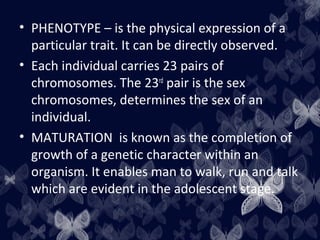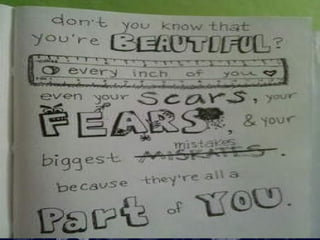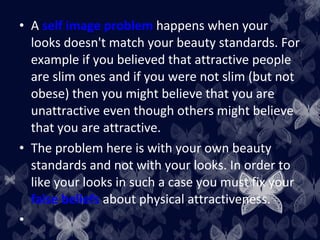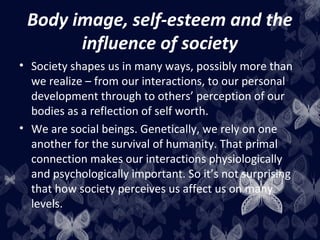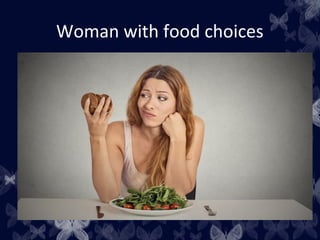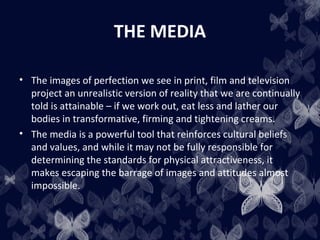Physical Self
- 1. Unpacking the Self - Physical Self Rubi R. Orbeta
- 2. Objectives: • Explore the different aspects of self and identity • Demonstrate critical, reflective thought in integrating the various aspects of self and identity • Identify the different forces and institutions that impact the development of various aspects of self and identity • Examine one’s self against the different aspects of self discussed in class
- 3. THE BIOLOGICAL BLUEPRINT A crucial aspect of the self is one’s physical features including the face, bodily structure, height and weight. However, people should also consider their physical competencies, valuation of physical worth, and perception of beauty. AM I BEAUTIFUL? DO PEOPLE FIND ME ATTRACTIVE? WHAT CAN I DO TO ENHANCE MY FEATURES?
- 4. However, the physical self is not only limited to what can be seen by the naked eye; underneath the skin is a dynamic system of biological and chemical processes that contribute to one’s physical features. Body structure, weight, height, skin color, hair color, and other physical characteristics do not just develop at random. These are triggered by genetic transformations and biological development through heredity.
- 5. • HEREDITY – is defined as the transmission of traits from parents to offspring. The traits are made up of specific information embedded within one’s gene, the basic unit of heredity. • GENOTYPE – refers to specific information embedded within one’s genes; not all genotypes translate to an observed physical characteristic. It can be determined by blood testing.
- 6. • PHENOTYPE – is the physical expression of a particular trait. It can be directly observed. • Each individual carries 23 pairs of chromosomes. The 23rd pair is the sex chromosomes, determines the sex of an individual. • MATURATION is known as the completion of growth of a genetic character within an organism. It enables man to walk, run and talk which are evident in the adolescent stage.
- 11. Jare Ijalana Nigerian tot dubbed ‘most beautiful girl in the world’
- 14. Beauty by numbers •Our attraction to another person’s body increases if that body is symmetrical and in proportion •If a face is in proportion, we are more likely to notice it and find it beautiful. •We perceive proportional bodies to be more healthy
- 20. Key points • The self as impacted by the body • The impact of culture on body image and self esteem • The importance of beauty
- 21. • A self image problem happens when your looks doesn't match your beauty standards. For example if you believed that attractive people are slim ones and if you were not slim (but not obese) then you might believe that you are unattractive even though others might believe that you are attractive. • The problem here is with your own beauty standards and not with your looks. In order to like your looks in such a case you must fix your false beliefs about physical attractiveness. •
- 22. Body image, self-esteem and the influence of society • Society shapes us in many ways, possibly more than we realize – from our interactions, to our personal development through to others’ perception of our bodies as a reflection of self worth. • We are social beings. Genetically, we rely on one another for the survival of humanity. That primal connection makes our interactions physiologically and psychologically important. So it’s not surprising that how society perceives us affect us on many levels.
- 23. • And it’s partly how society perceives our bodies that is of concern; we’re talking body image. So what does that involve?
- 24. Body image is both internal (personal) and external (society) This includes: • How we perceive our bodies visually • How we feel about our physical appearance • How we think and talk to ourselves about our bodies • Our sense of how other people view our bodies How we look has possibly never held as much societal importance or reflected so significantly on our perceived self worth.
- 26. The media in particular, has increasingly become a platform that reinforces cultural beliefs and projects strong views on how we should look, that we as individuals often unknowingly or knowingly validate and perpetuate. The more we look at perfect images of others and then look to find those same idealized characteristics in ourselves and don’t find them, the worse we feel about ourselves. It’s a cycle that breeds discontent. With such strong societal scrutiny it’s easy to see how the focus on how we look can slide into the dark side – negative body image.
- 27. Woman with food choices
- 28. The greater our discontent with how we measure up when compared to the societal or media supported norms, the more negative our body image, and the greater the risk for extreme weight or body control behaviours occurs. We’re talking… • Extreme dieting • Extreme exercise compulsion • Eating disorders • Extreme or unnecessary plastic surgery • Using steroids for muscle building
- 29. Who’s to blame for our body perceptions, be it good or bad? • Society gives us a number of reference points that shape our perceptions whether positive or negative. When it comes to our bodies there are a number of sources that affect us more than others.
- 30. TODAY’S EMBEDDED IDEALS – THE PHYSICAL • Life today sees image upon image of fashionably clad women, perfect skin, tiny waists, ample breasts, fashionably protruding behinds (of Kardashian and Beyonce fame) all with a weight of no greater than 59kg. • They are unrealistic images of beauty, genetically impossible for many of us to emulate. The same thing applies to the 6- pack or ripped abs shoved in the face of men via famous sportsmen and male fitness models, which for many is impossible to achieve without illegal steroids. • Yet we are told that these unattainable bodies are normal, desirable, and achievable. When we don’t measure up we develop a strong sense of dissatisfaction and the way that manifests can be ugly.
- 31. PREJUDICE – SIZE • Intolerance of body diversity has a lot to do with prejudice of size and shape in our culture. Being thin, toned and muscular has become associated with the hard-working, successful, popular, beautiful, strong, and the disciplined. • Being fat is associated with the lazy, ugly, weak, and lacking in will-power. • With this prejudice, fat isn’t a description like tall or redhead – it’s an indication of moral character and we are conditioned to think that fat is bad.
- 32. THE MEDIA • The images of perfection we see in print, film and television project an unrealistic version of reality that we are continually told is attainable – if we work out, eat less and lather our bodies in transformative, firming and tightening creams. • The media is a powerful tool that reinforces cultural beliefs and values, and while it may not be fully responsible for determining the standards for physical attractiveness, it makes escaping the barrage of images and attitudes almost impossible.
- 33. Those closest to us – family and friends • We learn from other people, particularly those closest to us about the things that are considered important. • Friendships are particularly important in body image development because we place high value on them, spend lots of time with our friends and develop shared experiences, values and beliefs.
- 34. Close friends
- 35. • Classrooms, University dorms and common rooms are often filled with negative body talk: “I wish I had her stomach” “I hate my thighs” “I feel fat.” Listening to this tends to reinforce the need to focus on appearance and make comparisons between us and other people’s bodies.
- 36. So how can we build a strong and positive body image? • Positive body image involves understanding that healthy attractive bodies come in many shapes and sizes, and that physical appearance says very little about our character or value as a person.
- 37. Women of different size
- 38. How we get to this point of acceptance often depends on our individual development and self acceptance. To get to that all important point of balance there are a few steps we can take: • Talk back to the media. All media and messages are developed or constructed and are not reflections of reality. So shout back. Speak our dissatisfaction with the focus on appearance and lack of size acceptance • De-emphasize numbers. Kilograms on a scale don’t tell us anything meaningful about the body as a whole or our health. Eating habits and activity patterns are much more important • Realize that we cannot change our body type: thin, large, short or tall, we need to appreciate the uniqueness of what we have – and work with it
- 39. • Stop comparing ourselves to others. We are unique and we can’t get a sense of our own body’s needs and abilities by comparing it to someone else • We need to move and enjoy our bodies not because we have to, but because it makes us feel good. Walking, swimming, biking, dancing – there is something for everyone • Spend time with people who have a healthy relationship with food, activity, and their bodies • Question the degree to which self-esteem depends on our appearance. If we base our happiness on how we look it is likely to lead to failure and frustration, and may prevent us from finding true happiness
- 40. • Broaden our perspective about health and beauty by reading about body image, cultural variances, or media influence. Check out a local art gallery paying particular attention to fine art collections that show a variety of body types throughout the ages and in different cultures • Recognize that size prejudice is a form of discrimination similar to other forms of discrimination. Shape and size are not indicators of character, morality, intelligence, or success • Each of us will have a positive body image when we have a realistic perception of our bodies, when we enjoy, accept and celebrate how we are and let go of negative societal or media perpetuated conditioning. But the media and society in general, are not all bad. As with most things, with the bad comes the potential for good and increasingly, people the world over are waking up to the negativity and conditioning that we are bombarded with daily.
- 41. “If you project a positive self- image, people will be more likely to see you as a positive, capable person.”
- 42. Defining Beauty Complete the sentences below. 1.For me, beauty means______________. 2.A beautiful person is ________________. 3.I am beautiful because _______________. 4.Mention names of people you know who are beautiful.
- 43. Assignment: Update your journal with insights about what you learned today about the physical self. 1.Define your self-image. What’s your internal voice saying? 2.Considering how you look now, is there anything you wish to change? Why or why not?
- 44. Thank you!!!!
Editor's Notes
- #4: The physical self is shaped by biological and environmental factors. It is surrounded by issues associated with health, hygiene, nutrition and standards of beauty, among others. The 3 Q’s concern the physical self, wc embodies physical appearance, what one sees in the mirror and what often triggers a person’s first impression of another.
- #7: Ex. A man has fair skin and a woman who has a brown skin produced a brown skinned male offspring. While you may assume that the newborn inherited only the skin color of his mom, a close examination of his genotype may reveal that he also got the gene for fair skin from his dad. Can be associated with the concept of dominant and recessive genes. However if the child in the future marries a woman who has a recessive gene for fair skin, their offspring may have fair skin. Dominant and recessive genes are dependent on alleles , which are alternate versions of a particular gene. Since human celss carry two copies of chromosomes they have versions of each gene.
- #17: In a few African and Asian cultures neck rings are worn usually to create the appearance that the neck has been stretched. The custom of wearing neck rings is related to an ideal of beauty: an elongated neck. ... Once a person's neck has adjusted to the neck rings, they have to leave the neck rings on permanently.





